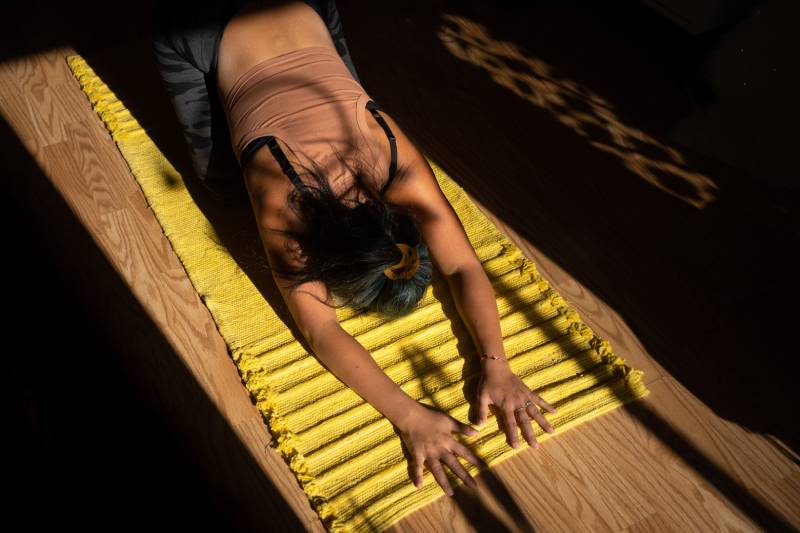Are you ready to go deeper down the yogic path and unravel some ancient yoga philosophy? If so, the Yamas are a great place to begin. The Yamas, which are the first limb of the eight limbs of yoga are moral codes or ethical restraints on living in the world. However, not all the Yamas are easy to understand and interpret in the modern world.
The most misunderstood Yama is the fourth Yama Brahmacharya. If you’ve come across the Yama and are confused about its meaning, don’t worry. This article will explain what Brahmacharya means both in the Yoga Sutras and in the modern world. Plus, we’ll discuss how you can practice the fourth principle in your daily life and on the mat.
Contents
Brahmacharya In The Yoga Sutras

Brahmacharya is first mentioned in the ancient Hindi text “The Yoga Sutras by spiritual teacher Patanjali. This text, written sometime in the early centuries CE, details the eight-limbed path, including the five Yamas. Chapter 2 of the Yoga Sutras lists the five Yamas. Verse 38 talks about Brahmacharya, saying, “when a yogi is established in divine conduct, great vitality is acquired.”
Brahmacharya translates to “going after Brahman” or “behavior that leads to Brahman,” but the most common translation is continence (abstinence). So who is Brahman, and why should you go after him?
According to Hindi teachings, Brahman is ‘the creator’ or higher power. Therefore, a spiritual seeker’s greatest and finest desire is to unite with god consciousness, and Raja yoga and the eight limbs provide a path to do so. So Brahmacharya’s meaning, the ‘right use of energy.’ is about using and directing your power correctly to bring you closer to God.
You should practice self-restraint to draw your attention away from worldly pleasures that lower your vibration and hold you back from experiencing divine love. To do this, you should seek to discover what drains your energy (hint: it is usually bad habits or overindulging). Gaining this self-knowledge will help you practice moderation and ‘the right use of energy.’
The other four Yamas are:
- Ahimsa (non-violence)
- Satya (truthfulness)
- Asteya (non-stealing)
- Aparigraha (non-coveting or non-greed)
Brahmacharya And Intimate Energy

Many people get confused about how Brahmacharya is relevant in the 21st century. This is because they interpret the energy being talked about in the sutras to be purely intimate energy and thus, believe the correct use of this is physical abstinence or celibacy.
This idea comes from Indian and Tibetan Buddhism, where monks would practice celibacy and other forms of self-restraint. Intimate energy is potent, so they would believe that refraining from intimate activities allows one to channel more energy towards reaching enlightenment.
However, in the 21st century, practicing celibacy to obtain enlightenment is redundant. In fact, all the most famous yoga teachers like T. Krishnamacharya and BKS. Iyengar raised families while sharing the practice of yoga and making it mainstream.
Therefore, a more modern interpretation of yoga Brahmacharya is the suggestion to choose your romantic partners carefully, considering who you share your energy with. It is also an invitation to look at intimate activity as a part of your spiritual life, going beyond the sensory pleasures it gives.
Some spiritual teachers and practitioners believe that we exchange energy with our romantic partners. Therefore, if we do not carefully select who we exchange vital energy with, we may take on negativity and lower vibrations and energy levels than our own.
How to Practice Brahmacharya In Everyday Life

Intimate energy is just one aspect of Brahmacharya. Moreover, Brahmacharya does not mean you must make a massive sacrifice like this and deprive yourself of any joy or pleasure. Following the path to Brahman or another divine presence simply means living with some self-restraint to protect your vital energy.
Let’s discuss further how we can incorporate Brahmacharya into our daily lives.
Identify where your energy is being wasted
Most of us have bad habits that drain our energy; some of the most common ones are:
- Not getting enough sleep
- Disrupting our sleep quality by scrolling through social media at night
- Binge eating or over-indulging in high-fat or sugary foods
- Over-working
- Consuming too much alcohol, caffeine, tobacco, or drugs
- Lack of physical exercise
- Addictive behaviors around intimacy, gambling, gaming, etc
By gaining awareness of the behaviors that drain our energy, we can change our bad habits and replace them with healthier ones. If we prioritize rest and focus on our health, we will not only use our energy in a better way, but we will experience more of it, too.
Slow down and connect to your senses
In our fast-paced lifestyles, it is not uncommon for us to eat quickly and chug down water without even noticing the taste of what we consume. Just like over-indulging, rushing can use up more energy than necessary, which is amusing as we rush to save time!
Therefore, another way to practice Brahmacharya is to do things slower and more mindfully so that we can connect to our breath and all the senses.
- Eat slowly, savoring the flavor of each bite.
- Take a few deep breaths in between each sip of water.
- Check-in with your body regularly, observing any impulses you have to overindulge or engage in energy-draining activities.
Don’t be afraid to make sacrifices
A famous quote goes, “If you don’t sacrifice for what you want, what you want becomes the sacrifice.” Brahmacharya says if we want to experience outer success and inner joy, we sometimes need to sacrifice things we enjoy for our goals and dreams.
For example, athletes regularly practice Brahmacharya as they have to deny themselves things they enjoy to keep their body and health in top form. Moreover, entrepreneurs who build a business from scratch have to give up simple pleasures like evenings watching TV with the family to make their business a success.
We all seem to seek a life of balance. However, Brahmacharya teaches us that sometimes our life must become temporarily unbalanced to experience real, long-lasting happiness.
How to Practice Brahmacharya In Yoga Practice

Like all the Yamas, Brahmacharya should be practiced both on the mat and off it. Here are a few ways modern yogis can follow the fourth Yama.
Move with your breath
As you know, yoga is all about connection with the breath, yet sometimes we lose focus or attention and thus, start to move in a disconnected way. When we do not align our breath with our movement, we lose energy rather than create it, which leads to the feeling of fatigue.
Therefore, syncing our breath to movement is about “the right use of energy” thus, authentic yoga is a practice of Brahmacharya. If you struggle to stay connected to your breath during yoga practice, consider joining classes.
In a group class, the yoga teacher regularly cues the breath, helping you maintain your awareness. In addition, as you move and breathe with the other yoga practitioners, you’ll create more universal energy, extending the benefits beyond yourself.
Do more meditation and pranayama
Many yoga classes in the western world focus solely (or at least predominantly) on asana and the physical benefits of the practice. This comes from the western idea that yoga is a way to get fit and create a nice body rather than a holistic tool for wellbeing and spiritual development.
Practicing only asana does not make your yoga practice balanced or holistic, as it lacks the other limbs like pranayama (breathwork) and dhyana (meditation). However, including more of such practices in your yoga routine will allow you to slow down, conserve energy, and connect deeper.
Moreover, both meditation and pranayama improve the flow of Qi (life force energy), which plays a massive role in our wellbeing and vitality.
Balance dynamic yoga with restorative styles
Fast yoga styles like power yoga are becoming increasingly popular due to the false belief that you should feel fatigued after yoga, like with a workout. However, no yoga text says that the purpose of yoga asana is to exhaust the body. Instead, asana helps calm the mind, preparing the body for meditation, in which fast-paced or vigorous movement is not required.
Again, Brahmacharya is about moderation. If you love power yoga, you don’t have to stop it completely. Instead, practice it in moderation combined with more restorative practices like yin yoga, Nidra, or meditation. You can split your routine between dynamic and therapeutic styles or combine them, like in “Vin to yin” or “flow and restore” classes.
In addition, purposely take more rests during your yoga practice. Stay longer in the child’s pose or downward dog whenever you need to conserve your energy. Slowing your approach will result in a more balanced nervous system and a nourished body free from fatigue!
Final Thoughts

Although the idea of Brahmacharya may seem confusing or unnecessary initially, this Yama has much relevance in modern-day life and western yoga practice. By following the principle of seeking moderation, we can experience greater wellbeing, vitality, and success and progress further along our spiritual path.


